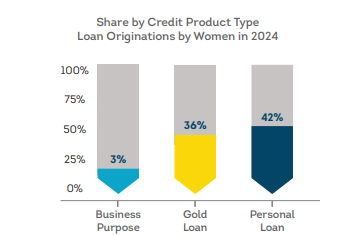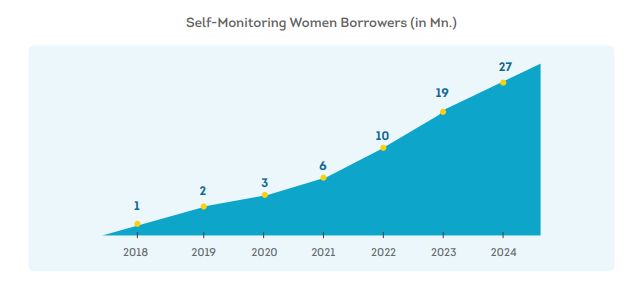Women in India are increasingly becoming credit-conscious and financially aware according to a new report by NITI Aayog’s Women Entrepreneurship Platform (WEP) in partnership with TransUnion CIBIL and Microsave Consulting. The data shows that 2.7 crore women are now actively self-monitoring their credit scores, a 42% rise in 2024. The number of women seeking credit have also grown at a CAGR of 22% since 2019.
The report titled “From Borrowers to Builders: Women’s Role in India’s Financial Growth Story” provides deep insights on the current state of women’s participation in the country’s financial landscape and also notes challenges and recommendations.
Highlights from the report
Women make nearly 50% of the Indian population but contribute only 18% to the GDP. The current growth trajectory in women’s participation in the labour force and financial inclusion can help push India’s growth story forward.
Rise in women borrowers
The women seeking credit have grown at a CAGR of 22% since 2019; a threefold growth between 2019 and 2024, with around 60% of the borrowers coming from semi urban and rural areas meaning a deeper footprint across the country apart from metros and tier 1 cities. Nearly 27% of the women borrowers are of age below 30.
Credit supply trends
Women borrowers’ share in business loans has grown by 14% since 2019. While the share of business loans for women has increased, majority of women borrowings are still loans against gold and credit for personal finance. Credit for business purposes accounted to 37 lakh new loan accounts of value Rs 1.9 lakh crore in 2024.

Women borrowers’ share in gold loans has increased by 6% between 2019 to 2024. Of the total loans availed by women, 36% loans were against gold, up from 19% in 2019. According to the report, 4 crore loans worth Rs 4.7 lakh crore were disbursed to the women in 2024.
42% of the loans availed by women during this period were for personal finance. The retail personal finance segment for women borrowers grew to 42% in 2024, up from 39% in 2019. A total of 4.3 crore such personal finance loans of value Rs 4.8 lakh crore were availed by women in 2024.
Credit monitoring trends
As of December 2024, a total of 2.7 crore women were monitoring their credit score, up 42% from 2023. The sharp rise in women self-monitoring their credit health indicates increasing awareness.

The growth is driven by the digitally fluent gen Z women, closely followed by millennial women. The number of gen Z women monitoring their credit health grew by 56% year-on-year whereas millennial women’s number grew by 38%. However, in terms of overall share, millennial women still lead with 52%, followed by 22% gen Z women.
In total, women make up 19.43% of the total self credit monitoring users, up from 17.89% in 2023.
The number of women self-monitoring their credit scores grew more in non-metro areas; 48% between December 2023 to December 2024, as compared to metro areas which grew by 30% during the same period.
According to the report, 44% of the women who start self-monitoring their credit scores see improvements in their credit scores within 6 months. And among those in 90+ days past due (DPD) category, 17.45% moved to a lower delinquency bracket within six months.
The number of women self-monitoring their credit score and classified as Prime and above grew to 1.19 crore as of December 2024, up from 82.2 lakh in December 2023.
The trends depicted in the report clearly indicate a correlation between active self-monitoring and improvement in the credit health.
Challenges to overcome
Despite the tremendous growth, women borrowers still face challenges in securing loans due to gender bias, lack of collateral and limited financial literacy among other factors.
Some of the challenges are:
- Credit aversion due to social norms, fear of default repercussions and complex application process.
- Poor banking experience resulting from a lack of proper advisory from the banks.
- Lenders still perceive women as higher-risk borrowers due to limited credit history and business experience. Report highlights that 79% of women owned businesses are self-financed with only 7% of MSME credit facilitated to women.
- The lack of necessary documentations, collateral and guarantors are also factors affecting credit readiness among women.
The facts and figures are based on the data available in the report. You can read the full report here.
